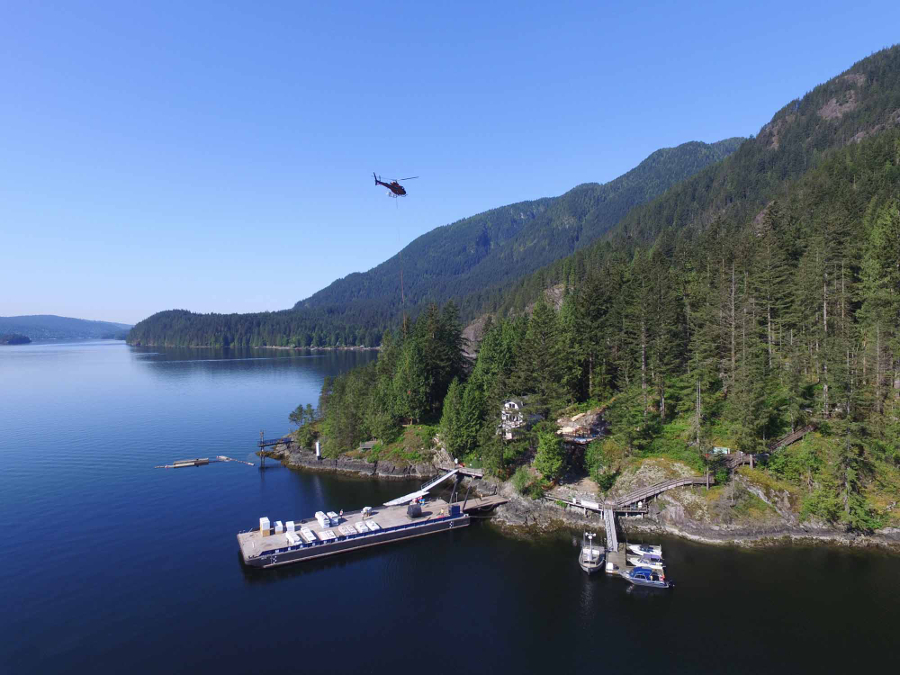IF YOU BUILD IT, THEY WILL COME
All custom homes come with their share of hurdles–add on a remote building site, and you’ll need the right builder as a partner, to help you handle every challenge. We chatted with three prominent builders working in some of B.C.’s most beautiful and remote places, about how they tackled successful projects for their clients.
By Catherine Dunwoody
The Builder
AJIA Custom Prefab Homes
The Location
A recreational home built on Indian Arm inlet
The Challenges
“When it comes to out-of-the-way, off-grid places, logistics are the big thing,” says AJIA president Norman Morrison. This house sits on top of a rock face, so that meant barge and helicopter were the only options for bringing materials to the site. Coastal weather was another factor to consider, as helicopters cannot fly through fog, “and if you book one, you pay whether fog rolls in or not,” says Morrison. The home’s location did not have a reliable water supply, either–a potential concern for meeting fire regulations.
The Solutions
“Being properly prepared is crucial, so our barge was set up with packages weighing about 1,800 pounds [more than 800 kilograms] each, ready for the helicopter to take over without being overweight carrying it.” AJIA pre-builds home components offsite, so they can be assembled when they arrive. To address installation of mandatory sprinklers without a conventional water supply, the solution was to put in big water storage tanks. “In our history as a company, we’ve learned to make our list and check it twice,” says Morrison, avoiding any blind spots or unexpected building challenges.
The Result
“Our client is very happy in this beautiful spot for their dream home.”
The Builder
Discovery Dream Homes West
The Location
Powell Lake, near Powell River
The Challenges
A water-access-only-location means that “every timber, shingle and window plus concrete has to be barged in and offloaded at the waterfront,” says Danny Mauro, design and consulting associate for Discovery. That means concrete trucks are unable to access the area, so “we look at other suggestions like ICFs [Insulating Concrete Forms], where the blocks are set up and concrete is mixed on site,” says Jason Sharpe, senior design manager and project coordinator. Mauro adds that “some remote builds have no AC power, so generators are typically the only means to power tools and other equipment,” usually gas-powered generators, requiring a fuel supply. “Getting workers to and from sites can also be challenging.”
The Solutions
The Discovery team finds that log, timber frame or panelized homes make for a faster assembly, being constructed from pre-cut materials, which saves time or on site. “We drive the loaded truck as close to the lake marina as we could, then unloaded individual skids on to a barge, then onto a smaller truck that goes to the site. A small crane truck transfers the skids,” says Mauro.
The Result
When clients choose a log-homestyle, Discovery is “able to save several weeks of framing time, as well as reducing trades to close the building in,” says Sharpe, as no drywall, mudding, tapping or wall insulation are required. By working smart, the team will finish within the limited seasonal weather window. “I guess the bottom line is: No building project is impossible if you have the right tools and approach,” says Mauro.
The Builder
Pan-Abode
The Location
An accessory building on an island located in Howe Sound.
The Challenges
“The island is a stone’s throw from the mainland, but there are no roads or bridges so it can only be reached by boat or barge,” says Pan-Abode president Rauvin Manhas. There was limited space on the building lot, which also came with extensive rules concerning design, setbacks, maximum height, plus the number and size of windows on the building. All materials had to be offloaded by hand, and moved via a smaller trailer pulled by a golf cart. “It was not possible to use heavy equipment during construction due to logistical restraints; all construction and assembly had to be done manually,” says Manhas.
The Solutions
Extra time was spent on design to ensure all regulatory requirements were met. A barge delivered heavy items like logs and beams, and because Pan-Abode logs are a maximum of six metres (20 feet) long and 36 kilograms (about 80 pounds) each, that allowed for relatively easy handling during construction without needing heavy equipment.
The Result
“Our customer’s accessory building met all of the extensive permit requirements for West Vancouver,” the municipality with rules that applied to the island build, says Manhas. “The owner is very happy.”


